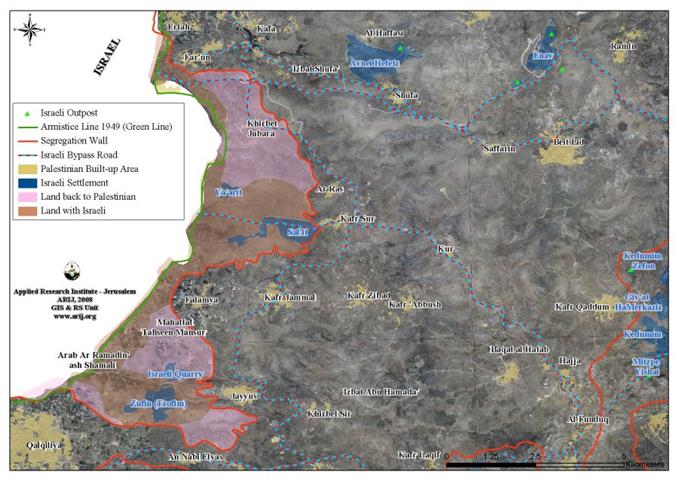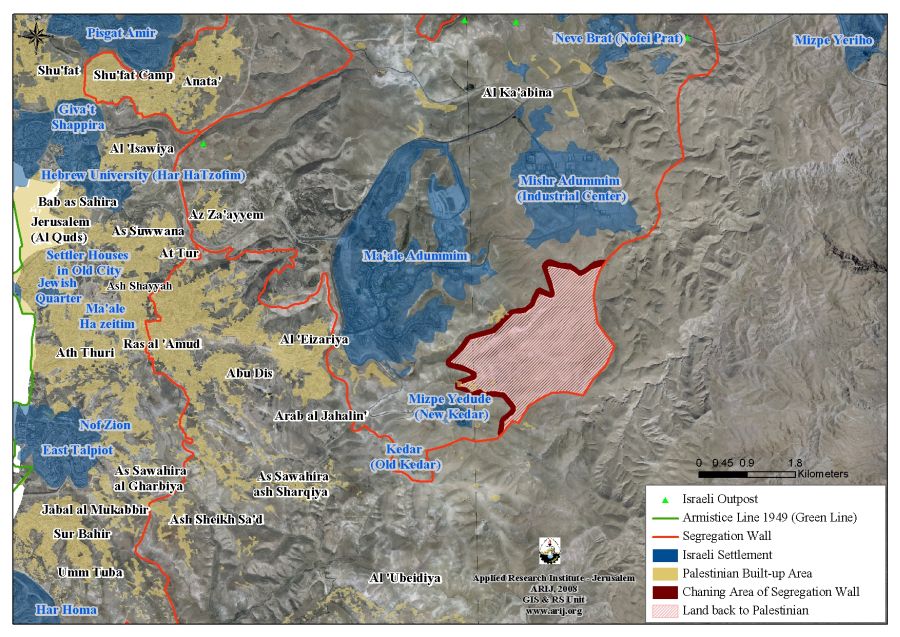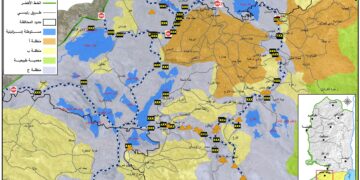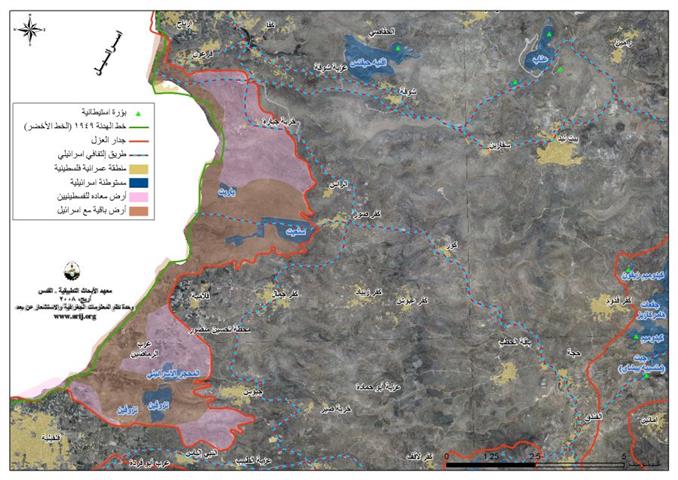'IDF shouldn't interfere in determining the rout of the wall. It should leave these decisions to the political echelon,' Israeli Chief of Staff Gabi Ashkenazi said on July 27, 2007
Chief of Staff's statements came after it became clear to him that the current route of the segregation wall in Jayyous area is not drawn on security basis, but to build new neighborhoods in northern West Bank settlements. These statements were not a surprise on its content. What surprising that Chief of Staff did not know that Mr. Danny Tirza, the Israeli army Colonel is responsible for planning the route of the segregation wall, and Tirza under his command. At the same time, these statements show the truth that the segregation wall haven't been built to serve Israel's security, but to confiscate land as much as it could from the Palestinians, to predetermines how the future Palestinian state will look like.
When Israel first started with the construction of the Segregation Wall in the West Bank in June 2002, the length of the Wall was 645 km; however, the route of the Wall kept changing to meet the Israeli Army's operational plan on the ground. Accordingly the Wall length varied since then several time, the latest of which was in August 2008, when the Israeli supreme court ordered the army to relocate part of the segregation wall section near male Adomim.
Next are most important changes that have occurred on the route of the segregation wall last year
Jayyous – Falma Section:
After a legal battle lasted five years, The Israeli government gave up to Jayyous and Falma villages' request. The Israeli army decided to move the segregation wall which was built on private Palestinian land from both villages, closer to the Green Line – at the cost of 50 million. The original route had been planned to accommodate the expansion of the settlement Tzofim, which itself is built on Palestinian land.
The original route section near Jayyous and Falma was extending 4.2 kilometers, built in 2003. Immediately after that the rights of the citizen raised lawsuit in the Supreme Court of Justice claimed that the wall separating villagers from their lands, which have remained on the western side of the wall next to Tzofim settlement. In June 2007 the courts ordered to dismantle this part of the wall and ordered to build new section extend 4.9 kilometers. In this case, the new route follows the suggestions of the 'dovish' Council for Peace and Security headed by Col. Shaul Arieli (ret.), who has co-authored a book on the segregation wall with the human rights lawyer, Michael Sfard called 'The Wall of Folly'.
The original route section where confiscated 28028 dunums. The new rout will be closer to the Green Line, not on the Green Line, and will give back 11628 dunums to the Palestinian; most of them are open spaces. 'i.e. 16,400 dunums remains to west of the segregation wall'. This also means that the villagers of Jayyous and Falamah still have to go through gates and get permits to farm their lands.
Map 1: Comparison between the old and the new route section near Falamya & Jayyous.
Maale Adomim Section:
The Israeli state attorney's office announced in August 2008, that in response to court petitions by Palestinian landowners from As- Sawahra shrqyeh village, the state would reroute a section of the segregation wall running east of Maaleh Adumim, restoring Palestinian access to about 4000 Dunums of farming and grazing land which the original plan would have placed on the Israeli side to meet the needs of 84 settler families in new Kedar settlement, also to include an abandoned mosaic. On the other hand, the Defense Department wants to keep this land to meet the expansion and growth aspirations of Maaleh Adumim at the expense of As- Sawahra shrqyeh village. The Israeli state attorney's office annunciation also came after legal battle lasted three years. See Map 2
Map 2 : The new route around Ma'ale Adumim settlement bloc.
Table 1: land use land cover for the changed section in Maale Adomim
|
Landuse Landcover 2006 for Area Back to Palestinian |
Area in Dunum |
|
Open spaces with little or no vegetation |
1716 |
|
Pastures |
2649 |
|
Palestinian builtup area |
27 |
|
Total Area |
4392 |
Source: ARIJ GIS unit – ARIJ 2008
Bil'in Section:
On September 4, 2007, the Israeli High Court of Justice ordered to reroute 1.7 kilometers Wall section, which was built on Palestinian lands of Bil'in village, within a distance of 500 meters away from the village's built up area and closer to the Green Line. The court's order came after a wave of petitions that were filed to the court by Palestinian residents who suffered desperate living conditions caused by the existing Wall to abolish it or if insists, to rebuild it on the 1949 Armistice Line (Green Line) or westwards.
Even after a year of the Israeli High court of Justice decision to dismantle the existing Wall section, nothing on the ground has been made yet as even no planned alternative route has been delivered to village's council. In August 2008 the chairperson of the Israeli Supreme Court Doreet Bainch and judges Eliezer Revlen and Eli Brooksteh, directed sharp criticism to the Israeli army because its ignorant to the court decision which asked the army to deliver a new rout for the wall in 45 days (10.5 months ago). Finally after months of inaction, and facing a legal challenge for not enforcing the court’s judgment, the authorities finally submitted a new plan for the wall at Bil’in in July this year. But Michael Sfard, the attorney who acts on behalf of Bil’in, will argue that this new proposal for the route of the wall meets none of the criteria and that the proposal constitutes contempt of court.
Haaretz daily newspaper reported on the 24th of April 2008. A spokesman of the Israeli ministry of defense, Shlomo Dror justified the delays in applying the court's order stems from 'budget constraints'. However, no budget constraints when it comes to building new housing units in the settlement as the last few months witnessed massive construction at the settlements!. In the other hand the Israel National News reported that 2008 wall budget stands at 250 million NIS, most of them will be directed for Re-routing the Segregation Wall. (70 million NIS for amendment).
Regardless of whether there are available budgets or not, the Israeli authorities are still procrastinating in implementing the Supreme Court decisions in the above mentioned sections. Israeli government policy rely dynamic approaches in order to maintain the Palestinian territories under its occupation, Israel appears as it wants to restore the usurped land to the Palestinian owners. But in fact the Israeli government still insists on ignoring that new routs of the segregation wall is also within the fourth of June 1967 line, and located on private Palestinian land
Israel continues to manipulate the facts on the ground with regard to demography and geography, in a discriminatory manner, annexing land, break-up communities, alter the population rates particularly in occupied East Jerusalem, all of which falls in their relentless scheme to force facts on the ground to its favor, and thus influence the final status negotiation to its desires. The Israeli-made isolated cantons will cause displacement among Palestinians from their communities; who will be segregated behind the Wall at the same time consolidate the stand of the 107 Israeli settlements that fall within the scope of the Western Segregation Zone. To corroborate such plan more than 90% of construction work, plans and tenders issued by the various Israeli governmental bodies are happening inside the segregated zone, particularly in occupied East Jerusalem. Ultimately, the Israeli Segregation Wall will annex some13% of the total area of the West Bank, which contradict Israel's claim that the Segregation Wall aim to serve 'security' reasons, on the other hand, it will pave the way for Israel to mark its eastern border with the occupied West Bank territory for the first time since its establishment in 1948. In the same frame came The Israeli foreign Minster Tzivi livni statements on April 26, 2007: that the construction of the segregation wall will advance the establishment of the Palestinian state.
To conclude:
The systematic nature of Israel's occupation policies (including the Segregation Wall) submits it to a further violation to the Human Rights and international law. Israel's military occupation and the accompanying policies it enforces in the Occupied Palestinian Territory (OPT) comprise a crime of apartheid according to the International Convention on the Suppression and Punishment of the Crime of Apartheid (1973). The Convention defines apartheid as: 'the imposition of various legislative measures on different racial groups while injuring the rights of one. Moreover, the crime of Apartheid comprises a 'crime against humanity' and 'a serious threat to international peace and security.
It is also a flagrant violation of international humanitarian law, specifically The Hague Regulations of 1907 and the Fourth Geneva Convention of 1949:
-
The Hague Regulations expressly forbids an occupying power 'to destroy or seize the enemy's property, unless such destruction or seizure be imperatively demanded by the necessities of war' (Article 23).
-
The Fourth Geneva Convention, the primary document of international law governing instances of military occupation, states in Article 49 that: 'The occupying power shall not deport or transfer parts of its own population into the territories it occupies.'
-
Article 53 of the Fourth Geneva Convention is also clear that: 'any destruction by the Occupying Power of real or personal property belonging individually or collectively to private persons, or to the State, or to other public authorities, or to social or cooperative organizations, is prohibited, except where such destruction is rendered absolutely necessary by military operations.'
-
The appropriation and destruction of Palestinian land is an especially serious violation of the Fourth Geneva Convention, Article 147 of which clearly prohibits, ''extensive destruction and appropriation of property, not justified by military necessity and carried out unlawfully and wantonly.'' Violations of Articles of the Fourth Geneva Convention constitute grave breaches of the Convention and should be prosecuted as War Crimes.
Prepared by
The Applied Research Institute – Jerusalem
















